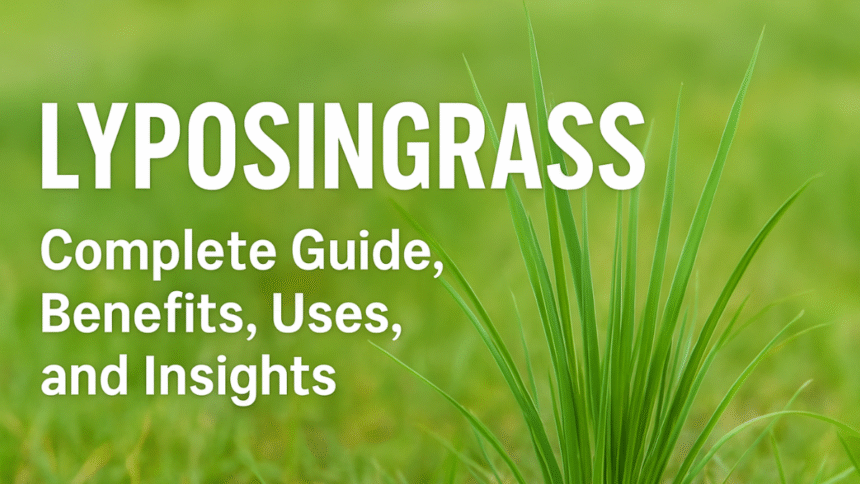In recent years, lyposingrass has gained significant attention in various fields, from health and wellness to environmental applications. Many people are curious about what lyposingrass is, why it matters, and how it can be used effectively. This guide takes a detailed look at lyposingrass, its background, importance, benefits, and potential challenges. By the end, you will have a clear understanding of why lyposingrass is becoming such a popular topic of discussion.
also read: https://usaenliinea.com/bntamnh-e/
What is Lyposingrass?
Lyposingrass is a term that is increasingly used in discussions about sustainable living, natural remedies, and innovative approaches to wellness. While it is still a developing concept, it generally refers to a type of natural grass-like plant or compound known for its unique properties. The versatility of lyposingrass allows it to be applied in several areas, such as:
- Health and herbal wellness
- Environmental sustainability
- Alternative agriculture and landscaping
- Research into natural bio-compounds
Because of its broad scope, lyposingrass is often described as more than just a plant—it represents a new way of integrating nature into modern solutions.
History and Origins of Lyposingrass
Though relatively new to mainstream awareness, lyposingrass has traditional roots. Many ancient practices incorporated similar grasses for healing, purification, and environmental balance. Over time, scientific interest has highlighted its unique characteristics, pushing it into the spotlight of modern research.
Researchers suggest that lyposingrass might have originated in specific regions with a rich biodiversity, where its resilience and natural growth patterns made it valuable to local communities. The term “lyposingrass” is now associated with modern interpretations, blending traditional knowledge with innovative science.
Key Characteristics of Lyposingrass
To understand why lyposingrass is gaining popularity, it is essential to know its main features:
- Resilient Growth: Lyposingrass can thrive in various climates, making it adaptable and eco-friendly.
- Nutritional Value: It contains natural compounds beneficial for health and wellness.
- Eco-Benefits: Known for soil enrichment and contributing to environmental balance.
- Versatility: Can be applied in health supplements, landscaping, and sustainability projects.
This mix of properties makes lyposingrass a rare natural resource with multiple uses.
Health Benefits of Lyposingrass
The wellness industry has shown particular interest in lyposingrass because of its health-related advantages. Let’s explore some of the reported benefits:
1. Natural Detoxification
Lyposingrass is believed to help the body eliminate toxins naturally. Its compounds may support liver function and digestive health, promoting a cleaner internal system.
2. Boosting Immunity
With natural antioxidants, lyposingrass can strengthen the immune system. This helps the body resist infections, reduce inflammation, and maintain overall wellness.
3. Digestive Support
Many herbal practitioners suggest that lyposingrass improves digestion by reducing bloating, improving gut health, and supporting nutrient absorption.
4. Stress Relief
Due to its calming nature, lyposingrass has been linked to stress management and relaxation. Herbal teas or supplements derived from lyposingrass are often consumed to relieve anxiety and improve sleep.
Environmental Benefits of Lyposingrass
Beyond personal health, lyposingrass plays a vital role in environmental well-being. Its ecological advantages include:
- Soil Enrichment: Enhances soil fertility and reduces erosion.
- Air Purification: Contributes to cleaner air by absorbing pollutants.
- Water Conservation: Requires less water than many traditional crops, making it sustainable.
- Wildlife Habitat: Provides shelter and food for smaller species in natural ecosystems.
In today’s world, where climate change and sustainability are urgent concerns, lyposingrass has the potential to make a significant difference.
Applications of Lyposingrass
The applications of lyposingrass are diverse and growing rapidly. Some of the most common uses include:
Herbal and Nutritional Products
Lyposingrass is increasingly used in teas, supplements, and natural remedies. Its detoxifying and immunity-boosting properties make it valuable in the wellness industry.
Landscaping and Agriculture
Because it is low-maintenance and eco-friendly, lyposingrass is popular for landscaping projects. Farmers also explore its potential as a sustainable crop.
Environmental Projects
Governments and environmental organizations look to lyposingrass for reforestation, soil recovery, and green projects.
Industrial Uses
There is ongoing research into whether lyposingrass fibers can be used in eco-friendly materials, packaging, and textiles.
Comparison: Lyposingrass vs. Traditional Grasses
| Feature | Lyposingrass | Traditional Grasses |
|---|---|---|
| Growth Needs | Low maintenance, adaptable | Often requires more care |
| Health Applications | Used in wellness and detox products | Limited to fodder and lawn use |
| Environmental Impact | Soil-friendly, eco-sustainable | Neutral or sometimes harmful |
| Economic Value | Growing in demand for health & eco | Primarily agricultural |
This table shows why lyposingrass is being viewed as a superior alternative in many areas.
Challenges and Limitations of Lyposingrass
Despite its many advantages, lyposingrass also faces some challenges:
- Limited Awareness: Many people are still unaware of its potential.
- Research Needed: More scientific validation is required to confirm health claims.
- Accessibility: In some regions, it may not yet be available in markets.
- Regulatory Approval: Herbal products often need government approvals, which can delay commercialization.
Recognizing these limitations ensures that expectations remain realistic while research continues.
Future of Lyposingrass
The future of lyposingrass looks promising. With more studies underway and increasing global interest in sustainable and natural solutions, it may become a major part of industries such as wellness, agriculture, and eco-innovation. Companies are already experimenting with new products, while environmentalists highlight its benefits in combating climate-related issues.
If awareness continues to grow, lyposingrass could play a vital role in both personal health and global sustainability.
FAQs About Lyposingrass
1. Is lyposingrass safe for daily consumption?
Yes, when used in moderate amounts as teas or supplements, lyposingrass is generally considered safe, though consulting a professional is recommended.
2. Can lyposingrass grow indoors?
Yes, with proper care and sufficient light, it can adapt to indoor environments.
3. Does lyposingrass help with weight management?
Some suggest it aids in digestion and metabolism, which may support weight goals.
4. Can lyposingrass be used in animal feed?
Yes, it may be suitable as a natural feed option due to its nutritional content.
5. What climates are best for lyposingrass cultivation?
It grows well in temperate and tropical climates, showing resilience in diverse conditions.
6. Is lyposingrass available in supplement form?
Yes, it is often found in capsules, powders, and herbal tea blends.
7. How does lyposingrass compare to lemongrass?
While both are beneficial grasses, lyposingrass is considered more versatile in environmental and health applications.
8. Can lyposingrass improve air quality indoors?
Yes, like many plants, it contributes to cleaner air by absorbing toxins.
9. Are there side effects of lyposingrass?
In rare cases, overconsumption may cause digestive discomfort, so moderation is key.
10. Is lyposingrass used in traditional medicine?
Yes, many cultures have historically used similar grasses for healing and wellness practices.
Conclusion
Lyposingrass is more than just a plant—it is a natural resource with significant potential in health, wellness, and sustainability. From detoxification and stress relief to soil enrichment and environmental conservation, its impact is wide-reaching. While challenges remain in awareness and research, the future holds great promise for lyposingrass.
As people search for healthier lifestyles and eco-friendly solutions, lyposingrass stands out as a symbol of balance between human well-being and environmental sustainability.
also read: https://usaenliinea.com/tahhiini/
also read: https://usaenliinea.com/bemyexchange/
also read:https://usaenliinea.com/susbluezilla/
also read: https://usaenliinea.com/ttps-docs-google-com-document-pii-deleted-2/
also read: https://usaenliinea.com/pappedeckel/
also read: https://usaenliinea.com/trucofax/
also read: https://usaenliinea.com/jhonbaby777/
also read:https://usaenliinea.com/hms-photovoltaik/
also read: https://usaenliinea.com/taboofantazy/







